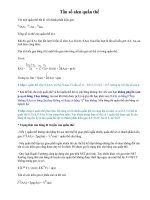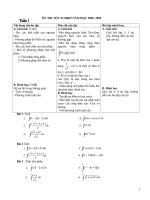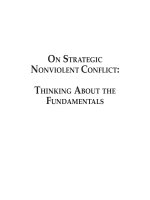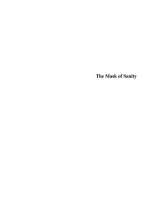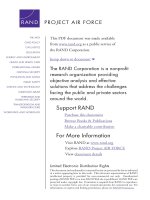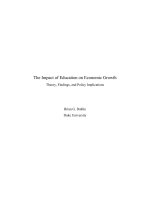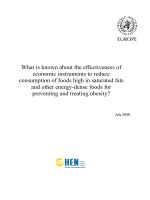On Strategic Nonviolent Conflict -Thinking About the Fundamentals potx
Bạn đang xem bản rút gọn của tài liệu. Xem và tải ngay bản đầy đủ của tài liệu tại đây (758.65 KB, 189 trang )
O
N
S
TRATEGIC
N
ONVIOLENT
C
ONFLICT
:
T
HINKING
A
BOUT
THE
F
UNDAMENTALS
O
N
S
TRATEGIC
N
ONVIOLENT
C
ONFLICT
:
T
HINKING
A
BOUT
THE
F
UNDAMENTALS
Robert L. Helvey
The Albert Einstein Institution
Copyright © 2004 by Robert Helvey
All rights reserved including translation rights.
Printed in the United States of America.
First Edition, July 2004
Printed on recycled paper.
This publication was prepared pursuant to the
United States Institute of Peace (USIP) Grant
SG-127-02S, September 19, 2002
This publication has been printed with the
assistance of the Connie Grice Memorial Fund.
Connie Grice was Executive Director of the
Albert Einstein Institution, 1986-1988. With
her experience in the civil rights movement
and deep commitment to a peaceful and just
world, she played a crucial role in the early
years of the Institution. Although her life was
cut too short, we who worked with her know
that she would have been very happy that her
memory could continue to support the work of
this Institution. The Connie Grice Fund was
established by her husband William Spencer
and her sister Martha Grice.
The Albert Einstein Institution
427 Newbury Street
Boston, MA 02115-1801, USA
Tel: USA + 617-247-4882
Fax: USA + 617-247-4035
E-mail:
Web site: www.aeinstein.org
ISBN 1-880813-14-9
“All men dream: but not equally. Those who dream
by night in the dusty recesses of their minds wake
in the day to find it was vanity, but the dreamers of
the day are dangerous men, for they may act on their
dream with open eyes, to make it possible.”
T. E. Lawrence, Seven Pillars of Wisdom
Dedicated to those who dream by day of victory over tyranny.
TABLE OF CONTENTS
INTRODUCTION ix
CHAPTER 1 Theory of Political Power 1
CHAPTER 2 Pillars of Support 9
CHAPTER 3 Obedience 19
CHAPTER 4 Mechanisms and Methods of 25
Nonviolent Struggle
CHAPTER 5 Problem Solving 41
CHAPTER 6 Strategic Estimate 47
CHAPTER 7 Operational Planning Considerations 67
CHAPTER 8 Psychological Operations 77
CHAPTER 9 Insights into Strategic Thinking 87
CHAPTER 10 Fear 101
CHAPTER 11 Leadership 107
CHAPTER 12 Contaminants 117
CHAPTER 13 Influencing External Audiences 125
CHAPTER 14 Consultations and Training 133
SOME FINAL THOUGHTS 143
On Strategic Nonviolent Conflict v
APPENDICES
APPENDIX 1 Glossary of Important Terms in 145
Nonviolent Struggle
APPENDIX 2 Methods of Nonviolent Action 153
APPENDIX 3 Example of Problem Solving Using 161
Staff Study Format
APPENDIX 4 Suggested Format for Preparing a 165
Strategic Estimate
FIGURES
FIGURE 1 Monolithic Model of Power 167
FIGURE 2 Pluralistic Model of Power 169
FIGURE 3 Pillars of Support 171
FIGURE 4 Pulling vs. Pushing 173
Pillars of Support
FIGURE 5 Loyalty Pie 175
BIBLIOGRAPHY 177
vi Robert L. Helvey
ACKNOWLEDGEMENTS
Without the strong and persistent encouragement of Peter Ackerman
from the International Center on Nonviolent Conflict and Harriet
Hentges of the United States Institute of Peace (USIP), I would have
never undertaken the challenge of writing this book. I would also
like to acknowledge the patience and encouragement of Ms. Judy
Barsalou, Program Officer at USIP.
Dr. Gene Sharp, founder and currently Senior Scholar of The
Albert Einstein Institution, was most helpful with comments and
suggestions. As he is the pre-eminent authority on strategic non-
violent struggle, I was reluctant to attempt a book on a subject that
he has so skillfully addressed in his many writings. One day, while
discussing my book, I expressed my reservations to him since he
had already written the bible on strategic nonviolent conflict (The
Politics of Nonviolent Action and From Dictatorship to Democracy) and
his response was, “How many books have been written about the
Bible?”
My brother, Frank Helvey, waded through draft after draft with
the critical eye of an appellate lawyer pointing out the need for pre-
cision since I would not be present to observe the reader’s expres-
sions or answer questions as I normally do when consulting or teach-
ing a class. Constance Meadows has never exhibited justified frus-
tration at seeing the manuscript returned so many times with major
revisions to be edited.
There are many others, too numerous to name, who have in-
fluenced my thinking and commitment to promoting the under-
standing and use of nonviolent struggle against oppressive regimes.
To all of them, I give credit. However, I take full responsibility for
any errors of commission or omission contained in this book.
vii
INTRODUCTION
The twentieth century was the most violent century in recorded his-
tory. Two World Wars resulted in the deaths of more than 200 mil-
lion soldiers and civilians. In addition, there were many limited,
but just as terrifying, wars of liberation, wars of conquest, and inter-
nal wars between people over political and religious beliefs. It is
doubtful that there was ever a day in the 20th century that signifi-
cant armed conflict was not in progress.
As advances in science and technology provide the means to
make the consequences of armed conflict increasingly destructive
of military targets, there is also the likelihood of even greater collat-
eral damage, that is, the unintended destruction of civilian life and
property. This collateral damage occurs not only because of the le-
thality of the specific weapons, but also because of the large num-
bers of weapons that are employed. Relatively inexpensive chemi-
cal and biological weapons of mass destruction and their ease of
transport and delivery have frightful consequences for collateral
damage to civilian populations. News coverage of the “smart
bombs” used in Desert Storm in the early 1990s led the American
public into a false belief that war strikes can be swift, clean, and
sure. However, the extensive use of precision guided munitions in
the war against Iraq in early 2003 by a United States-led coalition
should not be considered the new standard for bombardment since
few countries can afford the extensive use of these expensive weap-
ons and their supporting technologies. Thus, even in limited wars,
including civil wars, it is the civilians who will continue to bear the
brunt of modern warfare.
As the Cold War between the Soviet Union and the West began
to thaw in the last two decades of the 20th century, surpluses of
small arms, artillery, aircraft, military vehicles, and a wide assort-
ment of munitions became available in the international arms mar-
ket. Economies of scale in production of new weapons (that is, the
more items that are produced reduces the cost per item) also con-
tributed to making weapons available to buyers at a more afford-
able cost. Nations and commercial companies sent their arms sales-
men to market their merchandise. This affordability and availabil-
ix
ity of weapons ultimately facilitated the worldwide escalation of
violent conflicts.
One question raised by these developments in military tech-
nologies and by the proliferation of increasingly destructive weap-
ons is whether or not any principle is worth fighting for if the out-
come of the conflict may be devastation for both sides. Who can
really claim victory in a war that may destroy so much of the human
and economic resources of a nation that the objective of the struggle
cannot be obtained even by the winner? In the face of such destruc-
tion, adversaries have increasingly sought to avoid war through
policies of deterrence and negotiations. Deterrence policies have
been effective, especially in preventing nuclear war. Where parity
in the capacity to wage war has not been clearly established, how-
ever, armed conflicts continue to occur. Moreover, where ethnic and
religious factors are predominant, the calculus for initiating conflict
may lose its objectivity.
There will always be ideals worth fighting for and oppression
to be overcome. Some issues may not be resolvable through nego-
tiations alone, but armed struggle may not be a viable option for an
oppressed society, as the state often has the monopoly on military
and other instruments of political coercion. This does not mean that
oppressed people must then choose between submission and wag-
ing an armed struggle where defeat is nearly certain. There is a
third alternative to armed conflict for the pursuit of political change—
strategic nonviolent struggle. In this book, strategic nonviolent
struggle means:
nonviolent struggle that has been applied according to a
strategic plan that has been prepared on the basis of an
analysis of the conflict situation, the strengths and weak-
nesses of the contending groups, the nature, capacities and
requirements of the technique of nonviolent action, and
especially the strategic principles of that type of struggle.
1
The struggles for democracy in Burma, Belarus, Iran, Tibet and
Zimbabwe are examples of nonviolent struggles waged against op-
x Robert L. Helvey
1
Gene Sharp, There Are Realistic Alternatives, (Boston: The Albert Einstein
Institution, 2003), 38.
pressive regimes for worthy goals—those of ending tyranny and
bringing peace with justice to the people.
This book is written with hope that it may be of assistance to
those who are searching for or examining nonviolent options as an
alternative to armed struggle against an oppressive government or
foreign occupation. It is not a “how to” book on waging nonviolent
struggle. Rather, it offers a framework that encourages orderly think-
ing about the fundamentals of strategic nonviolent opposition to
state tyranny. It includes information on the theory, strategic plan-
ning, and operations for waging strategic nonviolent struggle that
has proved to be effective. Hopefully, the reader will find the book
organized in a way that it can be readily adapted for communicat-
ing its subject matter to others in a variety of training environments.
Strategic nonviolent struggle is advanced as an alternative to
armed conflict, in part, because of the reasonable likelihood that it
will result in fewer lives lost and less destruction of property. But
even if that were not so, experience has shown that nonviolent
struggle is an effective means of waging conflict against repressive
regimes. A military victory is achieved by destroying the opponent’s
capacity and/or willingness to continue the fight. In this regard,
nonviolent strategy is no different from armed conflict, except that
very different weapons systems are employed.
After gaining some familiarity with this book, some readers
may erroneously conclude that the preparation of a strategy and
supporting plans for waging a strategic nonviolent struggle entails
such complexity that only the most developed and financially se-
cure opposition groups could undertake the challenge. Not true.
The starting gate for the application of strategic nonviolent struggle
fundamentals is thinking about those fundamentals, and this book
not only addresses them but also challenges the reader to think about
applying these fundamentals for a particular cause. Unlike an air-
craft flight manual, there is no detailed check list here that must be
followed. Instead, there is a “check list” of ideas and suggestions to
guide one’s thinking in making a transition from dictatorship to
democracy.
Any writings or discussions on the subject of strategic nonvio-
On Strategic Nonviolent Conflict xi
lent struggle owe much to Dr. Gene Sharp, resident Senior Scholar
at the Albert Einstein Institution. He has spent almost five decades
examining conflict. Dr. Sharp, while studying at Oxford University
(1960-64), developed a theory and understanding of the nature of
social power that is as fundamental to understanding nonviolent
struggle as is the study of Clausewitz to understanding the nature
and theory of military conflict. Chapters 1-4 of this book are based
upon or derived from his considerable contributions to the study of
the theory and applications of nonviolent conflict. Among Dr.
Sharp’s many publications his three volume The Politics of Nonvio-
lent Action (1973) and From Dictatorship to Democracy (1993) are par-
ticularly important sources for the study of strategic nonviolent
struggle.
While I was attending Harvard University as an US Army Se-
nior Fellow at the Center for International Affairs in 1987-88, toward
the end of my thirty year career as a US Army Infantry Officer, I met
Dr. Sharp during a meeting of the Program for Nonviolent Sanc-
tions. He introduced his subject with the words: “Strategic nonvio-
lent struggle is about seizing political power or denying it to others.
It is not about pacifism, moral or religious beliefs.” These words got
my attention since my perception of “nonviolence” had been one
influenced by Vietnam era “flower-children, peaceniks and draft
dodgers.” Since then, Gene has served as my mentor in understand-
ing the principles, dynamics and applications of this potentially
powerful form of struggle, as a colleague in the work of responding
to requests for information by those engaged in resisting oppres-
sion, and as a good friend.
xii Robert L. Helvey
1
2
Dr. Sharp makes a distinction between social and political power. “Social
power may be briefly defined as the capacity to control the behavior of others,
directly or indirectly, through action by groups of people, which action impinges
on other groups of people. Political power is that kind of social power which is
for political objectives.” The Politics of Nonviolent Action, (Boston: Porter Sargent
Publishers, 1973) I: 7.
CHAPTER ONE
THEORY OF POLITICAL POWER
Political power is the totality of means, influences, and
pressures—including authority, rewards, and sanctions—
available to achieve the objectives of the power-holder, especially
those of government, the state, and those groups in opposition.
—Dr. Gene Sharp, The Politics of Nonviolent Action
The quest for power appears to be a natural appendage of all man-
kind and its institutions. It occurs between nations, within govern-
ments, between and within corporations, and even between friends.
2
Perhaps the most familiar to average citizens are power struggles
that occur over the allocation of tax revenues. Legions of lawyers,
lobbyists, and public relations specialists ply the interests of their
clients to achieve preferential tax treatment or to receive lucrative
government contracts. Sometimes, the benefits of such allocations
to the people who pay the taxes are questionable. Often, the influ-
ence on decisions for such allocations is obscured from public view.
For example, a cursory review of the US Defense budget process is
replete with cases of legislators forcing airplanes, ships, and weap-
ons upon the US Defense Department even though the military ser-
vices do not want them, particularly if they are outdated, poorly
designed or unnecessary surplus equipment. What governments
choose to fund can be inexplicable, at least to the average citizen
who knows little about special interests and their lobbyists. Even
how tax money is ultimately used can be paradoxical. Environmen-
talists express amazement when government departments find new
ways to undermine the very laws they are responsible for imple-
menting. The use of collected revenues has always been a political
issue in democracies and reflects a facet of the continuing efforts to
control and influence power.
2 Robert L. Helvey
More far-reaching in consequence than the competition over
the distribution of tax revenues, however, are the struggles for power
through control of government and the resultant relationships be-
tween the rulers and the ruled. When the needle on a continuum
between “freedom and tyranny” (admittedly subjective terms) points
strongly toward tyranny, there will be a desire for change by those
who are oppressed. What changes and how change will be attempted
depend upon the oppressed people’s understanding of the nature
and sources of power. Dr. Sharp describes two models to describe
the basis for power in society—one monolithic, the other pluralistic.
The Monolithic Theory of Power
One model to explain political power, described by Dr. Gene Sharp,
is referred to as the “monolithic” theory.
3
It portrays power as being
centered at the top of a solid, unchanging power structure [See Fig-
ure 1]. Occupiers of power portrayed by this monolithic model may
change for any number of reasons, but the structure of power itself,
that is, its pyramidal shell, is fixed as if in granite, irrespective of the
power mix within or the will to change from without. This theory
assumes that the people are dependent upon the good will, support
and decisions of the power holder and that the ruler determines
how this power is to be exercised. Preferably, the ownership of this
power structure changes through the process of orderly and legiti-
mate elections. However, under a tyrannical regime, a decision to
hold elections is often made by the ruler, with their outcomes gener-
ally pre-determined. General Ne Win in Burma and Robert Mugabe
in Zimbabwe are examples of despotic rulers who viewed election
rigging as an integral part of the election process. Occasionally dic-
tators miscalculate and fail to take the necessary steps to ensure the
desired result of an election. For example, the military regime in
Burma was shocked when it authorized an election in 1990 and lost.
3
A complete discussion of Sharp’s conception of the nature of political power
can be found in Volume I of The Politics of Nonviolent Action, pp. 7-10. In the
introductory chapter of this definitive work, Sharp delineates a common miscon-
ception about the structure of political power.
On Strategic Nonviolent Conflict 3
Its response to this unexpected setback was to refuse to accept the
will of the electorate and to arrest opposition political leaders.
Authoritarian regimes are comfortable when their public ac-
cepts (or acquiesces under pressure to) this monolithic
conceptualization of power. The mere fact that they hold power
gives them the authority to rule and dictates the obligation of the
people to submit, the desires of the ruled notwithstanding. The co-
ercive power of the state under this model is viewed as a primary
and legitimate means of enforcing compliance. The twentieth cen-
tury offers a multitude of examples. In the 1930s and 1940s, the
Soviet Union leader Josef Stalin caused the murder of almost 20 mil-
lion people who were deemed to be real or potential threats to his
hold on power—about the same number of Soviet citizens who died
during the war against Germany in World War II.
To undermine and remove tyranny through nonviolent con-
flict, one must move beyond the conceptual bounds of the mono-
lithic power structure to identify and assess the actual distribution
of power in all of its forms. While the monolithic model of power is
a useful analytical tool to the study of how despots obtain, hold and
pass the reins of power, using this model as a guide to thinking about
political change places a severe limitation on the options that can be
considered. While it is important for “dreamers of change” to be
aware of the monolithic model of power, in order to convert dreams
into action they will find more success by substituting a model that
views power, its attainment, and its loss in a completely different
light—as one with “pluralism” as its guiding feature.
The Pluralistic Model of Power
Another helpful model to understand the nature of power is referred
to by Dr. Sharp as the pluralistic model [See Figure 2]. Unlike the
monolithic model, a solid, unchanging structure with power con-
centrated at the top, this theory portrays political power as being
pluralistic and fragile. Sources of power are identified as residing
among the people throughout society, with the power holder able to
exercise only that power that the people permit. In other words,
4 Robert L. Helvey
the ruler can only rule with the consent and cooperation of the
people. That consent and cooperation may be willingly given or it
may be coerced. Consent may be a result of indifference on the part
of some in society, or even cultural influence upon obedience pat-
terns. In any event, the important point of the pluralistic model of
power is that, since the people provide the ruler with the sources of
his power, then the people can also withdraw their consent to be
ruled by withholding the sources of power they collectively pro-
vide to the regime.
According to Dr. Sharp there are six sources of power that are
the key to understanding its pluralistic nature. As will be discussed
below, it is these enumerated sources of power over which control,
substantial influence, or neutralization is sought. These sources of
power find expression in organizations and institutions, called “pil-
lars of support”, discussed in Chapter 2.
1. Authority
Authority is the basis for claiming the right to rule and for demand-
ing obedience from the ruled. Election results are often cited as the
validation of authority to govern. This is why so many authoritar-
ian regimes insist on holding elections and then stuff the ballot boxes,
intimidate the electorate, limit the campaign activities of opponents,
and refuse to acknowledge or accept unfavorable outcomes. Legiti-
macy is critically important to any government, and to be perceived
as exceeding constitutional authority or being an outlaw regime has
potentially serious consequences both internally and within the in-
ternational community.
Internally, the loss of apparent legitimacy may become a major
factor for the legitimization of political opposition. Using the con-
cept of the “social contract,” political opposition may proclaim that
if the government has committed a material breach of the constitu-
tion of a nation, the contract between the people and the govern-
ment has been violated, providing the basis for renouncing the obli-
gations to obey, support and cooperate with the regime.
Externally, the loss of legitimacy by a regime may make the
On Strategic Nonviolent Conflict 5
international community receptive to calls for economic and politi-
cal sanctions against it. Political and economic boycotts can weaken
such regimes, as happened to the apartheid regime in South Africa
and the dictatorship in Burma. Suspension of Zimbabwe from the
British Commonwealth in 2002 was a profound statement that the
Mugabe regime was not welcome to sit among democratic govern-
ments that had transitioned from colonialism to independent de-
mocracies. Moreover, democratic opposition groups are more likely
to obtain outside financial and moral support once an authoritarian
regime’s authority to rule has been seriously eroded. By themselves,
however, these international gestures of support are never sufficient
to remove a ruler from power. Moreover, such sanctions can also be
counter-productive if their effects do more harm to the public than
to the regime.
2. Human Resources
The numbers of people who support, cooperate with, and yield to
the ruler are an important determinant of a regime’s power. This is
not meant to suggest that if a majority of people do not like the in-
cumbent leaders then a regime change is inevitable. It only means
that the potential for change is present. History is replete with ex-
amples of oppression of the majority by a minority. On the other
hand, strategic nonviolent struggle cannot succeed without the ac-
tive support and cooperation of the majority. In a struggle for de-
mocracy, numbers are important!
3. Skills and Knowledge
Governing is much more complicated than ever. At the beginning
of the 21st century, the President of the United States of America is
widely accepted as being the most powerful person in the world.
Yet, this most powerful ruler knows little or nothing about the com-
plicated tasks of maintaining airplanes and flight schedules, admin-
istering maritime law, conducting criminal investigations, collect-
ing taxes, developing war plans, distributing food, developing and
6 Robert L. Helvey
servicing communications networks, and a host of other
proficiencies. The point is that skills and knowledge provided by
the people permit governments, at all levels, to function. Without
such contributions, a government collapses.
4. Intangible Factors
While it is difficult to measure their importance, intangible factors
such as religion, attitudes toward obedience and submission, a sense
of mission, or cultural norms can affect a ruler’s relationship with
the public. For example, there was a period in which there was an
acceptance by many in some societies of the “divine right of kings,”
the belief that rulers were agents of God on earth. To disobey the
ruler was thought to be disobedient to God. In other societies, such
as Japan, the Emperor was considered to be a God-king. Democ-
racy would have been impossible under those circumstances. At
the turn of the 21st century, there were instances of the merging of
the Islamic religion and traditional political power in some govern-
ments. While it is entirely appropriate to “render unto Caesar that
which is Caesar’s,” the debate must first be held over what exactly
belongs to him. After all, democracy is predicated upon the belief
that any power the ruler has is “on loan” from the people.
5. Material Resources
“He who pays the piper calls the tune” most certainly applies to poli-
tics. Control over the economy, property, natural resources, commu-
nications and transportation is an important aspect of the limits of
power over the public. For example, where the state owns all farm-
land, it effectively controls a significant part of the lives of all farm
families. In a similar fashion, where censorship prevails, the lives of
all those involved in all aspects of journalism are controlled or influ-
enced by the government. In countries where the oil industry has
been nationalized, there is less dependence upon the public for tax
revenues. This lack of dependence on tax revenues from the people
has the effect of centralizing the power of the purse for governments.
On Strategic Nonviolent Conflict 7
6. Sanctions
The ability to coerce compliance and support for government laws,
including rules and regulations, is limited by the support, coopera-
tion and acquiescence of the public. Sanctions are used both to pun-
ish and to deter unacceptable behavior. Sanctions need not be un-
duly harsh or extreme, such as executions or imprisonment, to be
effective. Denial or termination of employment, loss of retirement
benefits, limitation on educational opportunities and promotions,
travel restrictions (denial of passport), imposition of “eminent do-
main” of property, denial of access to water, and other sanctions can
all be effectively employed to promote submission. In some au-
thoritarian regimes, the media practices self-censorship because the
government has the capacity to close down publishers and news
organizations through the control of the distribution of newsprint
or the revocation of radio and television licenses. Such sanctions
are commonplace.
Sanctions are tools of every government. Most often they are
used to curb anti-social behavior. At other times, they have been
used as weapons to terrorize and to punish populations for political
ends. For example, Nazi Germany used collective punishment to
deter future actions of underground movements resisting German
Army occupation. At the turn of this century, the Israeli govern-
ment justified collective punishment as a means to deter acts of ter-
rorism. Aside from the fact that punishing a group for the acts of
individuals may be a violation of basic human rights, its use as an
effective deterrent is questionable. Indeed, collective punishment
and assassinations may have an effect opposite of that expected and
desired. Collective punishment may result in a determination to
retaliate rather than as a deterrent to future acts of violence.
Summary
Chapter 1 examines two models of power. The monolithic model
portrays power as being exercised in an unchanging structure in
which the people are dependent upon the ruler. The pluralistic model
8 Robert L. Helvey
sees power being exercised quite differently, with the ruler’s being
dependent upon the people. The sources of power that the people
provide to a ruler are also identified, and should these sources of
power be withheld from a ruler, his ability to govern would be im-
possible.
Descriptively, the various structures that permit and sustain
the day-to-day operations of government are referred to as its “pil-
lars of support”. Thus, the sources of power find expression in or-
ganizations and institutions within and outside of government [See
Figure 3, Pillars of Support]. Opponents of an authoritarian regime
also require pillars of support. When important pillars of support
are sufficiently undermined, the government, or the opposition, col-
lapses just as a building will collapse upon itself when its support
structure is weakened and gives way.
9
CHAPTER TWO
PILLARS OF SUPPORT
And Delilah said to Samson, Tell me, I pray thee, wherein
thy great strength lieth, and wherewith thou mightest be bound
to afflict thee.
—Judges, 16:6
Organizations and institutions are comprised of a mixture of sources
of power identified in the previous chapter. The sources of power
made available through these groups provide the government with
its ability to rule. Any regime will rely on some pillars of support
more than on others. At the same time, authoritarian regimes at-
tempt to limit the expansion and strength of the opposition’s pillars
of support. It should not be surprising that in a strategic nonviolent
conflict, the operational focus for planners is primarily about the
alignment and capabilities of pillars of support.
Identification of Pillars of Support
The identification and analysis of pillars of support are fundamen-
tal when opponents of a regime begin to think about any nonviolent
strategy. Until the primary pillars of the regime are undermined,
neutralized or destroyed, there is little prospect of political reform
or regime change. Those waging a nonviolent struggle against an
authoritarian regime, therefore, must give keen attention to key in-
stitutions and organizations.
Police
The motto “To protect and serve” is descriptive of the image most
police departments worldwide seek to project to the public. How-
ever, the identity of who is being protected and served is not always
the public. Instead, this most visible and omnipresent “face” of gov-
ernment sometimes gives priority to the task of protecting and serv-
ing a corrupt and repressive regime.
10 Robert L. Helvey
It is a common sense assumption that where corruption is sys-
temic, reform is most difficult, if not impossible, without a regime
change. Even in democratic societies, once corruption has been im-
bedded within the police structure, reform can occur only by re-
placing the individuals to whom the police report. The positive as-
pect of having local police under the supervision of locally elected
officials is that the people can hold someone directly responsible for
the actions of the police department personnel. Where there is a
national police force, exerting influence over police behavior at the
local level becomes more difficult.
Citizens do not need to wait for a regime change to begin chang-
ing the attitudes and behavior of police personnel. There are a few
factors to keep in mind concerning the police. First, police normally
live in the communities that they serve. Therefore, their families,
relatives, acquaintances and friends have developed a network of
relationships (e.g., schools, businesses, religious organizations, and
social groups). If the government, then, characterizes those people
in the community who oppose the regime as criminals, spies, or ter-
rorists, the police have another reference point by which to evaluate
government propaganda. Dr. Gene Sharp, who lived in Norway
while doing research on the Norwegian resistance to German occu-
pation during WW II, delights in recounting stories of the local po-
lice “faithfully” carrying out the orders of the German authorities.
In one instance, the local police contacted the family of person to be
arrested with the request that the suspect be informed of his im-
pending arrest, complete with the day, hour and minute that the
citizen could expect to see the arresting officers at his home.
Secondly, police forces carrying out the orders of a dictator
should not, in general, be viewed as the enemy of the people. They
are servants of a system that has failed. It is the system that needs to
be replaced, not the thousands of honest and honorable people whose
training and skills are necessary to serve and protect a democratic
society. Of course, there may be some who need to be singled out
for criminal prosecution on charges of murder, torture, or looting,
but the focus should be on those individuals, not all who serve in
the police forces.
On Strategic Nonviolent Conflict 11
Military
The use of military force to stay in power is viewed as the “trump
card” by authoritarian regimes. Unlike police personnel who live
and work in the local community, military units are often separated
from civilian society, with their own housing, shopping areas, hos-
pitals and schools. This separation from the public tends to hinder
the development of personal relationships between military and ci-
vilian families. When a government decides to intervene with army
forces in open political conflict, there is less incentive on the part of
military units to exercise restraint in the use of violence. During the
uprising in Burma in 1988, and a year later, in China, the govern-
ments dispatched Army units from outside the immediate areas of
intervention. In these circumstances, soldiers were considered by
authorities to be more reliable than the local police and militia, and
thus more responsive to orders. In some countries, where large dem-
onstrations are anticipated, specially trained and equipped riot con-
trol units are established to raise the threshold for requiring mili-
tary intervention.
The time to develop plans to undermine the willingness of the
Army to intervene against civilian protesters is well before a
government’s decision to employ them is made. Key to any plans
for undermining the willingness of the Army to commit forces against
protesters is to convince them that their own lives and the lives of
their families are not threatened and that professional soldiers will
have a secure future under democratic rule.
The actions of military units in response to orders are influ-
enced by the attitudes, values and professionalism of its leadership.
Officers generally view themselves as patriotic, loyal, and politically
conservative. Their “professionalism” sometimes leads them to
blindly support political leadership. The German General Staff un-
der Adolf Hitler reportedly disagreed with his political aims, but,
nevertheless, they developed the military plans to carry out the will
of the Fuehrer. The key point here is that Hitler, as leader of the
largest party in the German Reichstag, and having been appointed
Chancellor in accordance with the constitution, was considered to
12 Robert L. Helvey
be the legitimate ruler.
The assimilation of democratic values into military culture is a
major factor in limiting the use of the military’s destructive power
against the citizenry. Another factor is the perception of military
leaders that there will be an important role for them under a demo-
cratic government. Both of these factors require time and careful
thought in how to promote these ideas. One significant reason why
the Serbian nonviolent movement had so few casualties when the
Parliament was seized by thousands of protesters in October 2000
(one person died of a heart attack; another died in a traffic accident)
was the Army’s decision not to intervene in a “political” matter. No
doubt, this decision was influenced by the fact that the democratic
movement was clearly winning and members of the military had an
interest in positioning themselves for a role in the post-Milosevic
government.
Civil Servants
Civil servants are often maligned, criticized, ridiculed, and under-
valued. Sometimes, these government bureaucrats are thought of
as a colony of ants—thousands of nameless, faceless, mindless work-
ers doing their own little tasks, going to and fro from their little
cubby holes. Yet, political leaders, like the dependent “queen” of
the ant colony, cannot survive without the obedient, skilled civil ser-
vants carrying out these seemingly innocuous activities. These are
the people that translate orders into actions: they issue regulations,
assess and collect taxes, prepare budgets, run schools, input infor-
mation into thousands of databases, make purchases for the gov-
ernment, control the airways and harbors, staff embassies, maintain
communications systems, and, in fact, perform all of the tasks that
keep regimes functional. No government can operate without them.
Opposition groups who adopt strategic nonviolent conflict to
seek regime change and democratic reform must understand the
importance of winning the support of government employees. But
it must also be understood that the very livelihoods of government
employees depend upon their obedience to their government em-
On Strategic Nonviolent Conflict 13
ployer, and, as such, few employees can openly oppose the govern-
ment until there is clear evidence that other pillars of support for
the ruler have been seriously weakened. Nevertheless, commitment
to an opposition movement by government employees, even if not
openly expressed, can contribute to the advancement of the
movement’s cause in ways limited only by the imagination.
Media
If a popular movement for democratic change is to be successful, it
must have the means to communicate its messages to its target au-
diences. Authoritarian regimes know this and attempt to deny or
limit such access, leading to the creation of cyber warfare centers
and draconian laws restricting the possession or use of computers
and fax machines. Burma, for example, has imposed long prison
terms for “unlicensed” machines. Ownership and use of satellite
telephones are sometimes restricted, and governments sometimes
jam opposition groups’ television and offshore radio broadcasts in
attempts to close off information to the public.
Control of the press and other internal forms of mass commu-
nication by an oppressive government can be easily accomplished.
The establishment of publication review boards that require the sub-
mission of all books, magazines and newspapers prior to distribu-
tion has sometimes been very effective. There is a strong incentive
for self-censorship when the review does not occur until after all pub-
lication expenses have been incurred. Newspapers, other publica-
tions, television and radio stations can have their licenses revoked,
their equipment confiscated, and their owners and editors physically
intimidated. To overcome these internal constraints, offshore pro-
ductions are now rather common, whether it is a Burmese radio sta-
tion broadcasting from Norway or an Iranian television station in
California beaming interviews with opposition leaders to audiences
in Tehran. The possibility of mass communication originating out-
side a country’s border is exemplified also by the Serbian pro-democ-
racy movement. Over 60 tons of leaflets were shipped into the coun-
try and distributed within a few days prior to the election in 2000.
14 Robert L. Helvey
Business Community
Even under the most centralized, socialistic authoritarian regimes,
business communities play important roles in the economy. They
provide to the people goods and services that the government does
not supply. Often, governments give tacit approval to illegal black
market activities to reduce incidents of politicized public frustra-
tion over shortages of consumer goods.
There is a downside to working with business communities,
especially foreign and transnational. It is a perception that interna-
tional firms prefer to work with authoritarian regimes rather than
with more open and democratic governments. There are fewer co-
ordination points once the ruler has been convinced of the rewards
for making a deal. Working conditions, wages, and unions are often
matters that the ruler can handle quietly and efficiently. The point
is that international firms may have no particular interest in whether
or not a government is democratic or tyrannical. What matters to
them is profit. The challenge for a democratic movement is to con-
vince these companies that change is coming and that it may, in the
future, be important for them to be perceived as having been at least
neutral in the actions that they have taken.
On a positive note, members of local and foreign business com-
munities often have existing networks of contacts with local, regional
and foreign businesses. When it is in their interest to do so, they can
provide important resources including money, couriers, and advi-
sors for a democratic struggle.
Youth
A primary concern of authoritarian regimes is to prevent young
people from becoming politicized unless that politicization is in sup-
port of and controlled by the government. As long as students and
other youth are not permitted to become an organized challenge to
the stability of the government, opposition groups are deprived of
the traditional vanguard for accelerated political change. Some ways
governments keep students from becoming active in political oppo-

